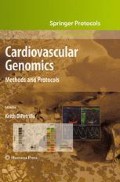Abstract
It is increasingly common to combine genome-wide expression data with quantitative trait mapping data to aid in the search for sequence polymorphisms responsible for phenotypic variation. By joining these complex but different data types at the level of the biological pathway, we can take advantage of existing biological knowledge to systematically identify possible mechanisms of genotype–phenotype interaction. With the development of web services and workflows, this process can be made rapid and systematic. Our methodology was applied to a use case of resistance to African trypanosomiasis in mice. Workflows developed in this investigation, including a guide to loading and executing them with example data, are available at http://www.myexperiment.org/users/43/workflows.
Access this chapter
Tax calculation will be finalised at checkout
Purchases are for personal use only
References
Hedeler, C, Paton, N, Behnke, J, et al. (2006) A classification of tasks for the systematic study of immune response using functional genomics data. Parasitology 132(Pt 2): 157–167.
Mitchell, J, McCray, A, Bodenreider, O. (2003) From phenotype to genotype: issues in navigating the available information resources. Methods Inf Med 42(5): 557–563.
Liolios, K, Tavernarakis, N, Hugenholtz, P, et al. (2006) The Genomes on Line Database (GOLD) v.2: a monitor of genome projects worldwide. Nucleic Acids Res 34: D332–D334.
Fisher, P, Hedeler, C, Wolstencroft, K, et al. (2007) A systematic strategy for large-scale analysis of genotype phenotype correlations: identification of candidate genes involved in African trypanosomiasis. Nucleic Acids Res 35(16): 5625–5633.
Köhler, J, Baumbach, J, Taubert, J, et al. (2006) Graph-based analysis and visualization of experimental results with ONDEX. Bioinformatics 22(11): 1383–1390.
Macdonald, M, Ambrose, C, Duyao, M, et al. (1993) A novel gene containing a trinucleotide repeat that is expanded and unstable on Huntington's disease chromosomes. The Huntington's Disease Collaborative Research Group. Cell 72(6): 971–983.
Glazier, A, Nadeau, J, Aitman, T, (2002) Finding genes that underlie complex traits. Science 298(5602): 2345–2349.
Brown, A, Olver, W, Donnelly, C, et al. (2005) Searching QTL by gene expression: analysis of diabesity. BMC Genet 6(1): 12–20.
Doerge, R. (2002) Mapping and analysis of quantitative trait loci in experimental populations. Nat Rev Genet 3(1): 43–52.
Schadt, E. (2006) Novel integrative genomics strategies to identify genes for complex traits. Anim Genet 37(1): 18–23.
Stevens, R, Tipney, H, Wroe, C, et al. (2004) Exploring Williams-Beuren syndrome using myGrid. Bioinformatics 20(1): 303–310.
Hitzemann, R, Malmanger, B, Reed, C, et al. (2003) A strategy for the integration of QTL, gene expression, and sequence analyses. Mamm Genome 14(11): 733–747.
Flint, J, Valdar, W, Shifman, S, et al. (2005) Strategies for mapping and cloning quantitative trait genes in rodents. Nat Rev Genet 6(4): 271–286.
Dharmadi, Y, Gonzalez, R. (2004) DNA microarrays: experimental issues, data analysis, and application to bacterial systems. Biotechnol Prog 20(5): 1309–1324.
Kell, D. (2002) Genotype-phenotype mapping: genes as computer programs. Trends Genet 18(11): 555–559.
Kell, D, Oliver, S. (2004) Here is the evidence, now what is the hypothesis? The complementary roles of inductive and hypothesis-driven science in the post-genomic era. Bioessays 26(1): 99–105.
Illuminating the black box. Nature 2006, 442(7098): 1.
Stein, L. (2003) Integrating biological databases. Nat Rev Genet 4(5): 337–345.
Stein, L. (2002) Creating a bioinformatics nation. Nature 417(6885): 119–120.
Oinn, T, Addis, M, Ferris, J, et al. Taverna: a tool for the composition and enactment of bioinformatics workflows. Bioinformatics 20(17): 3045–3054.
Tomfohr J, Lu J, Kepler T. (2005) Pathway level analysis of gene expression using singular value decomposition. BMC Bioinformatics 6: 225.
Oinn, T (2003) Talisman-rapid application development for the grid. Bioinformatics 19(1): i212–i214.
Birney, E, Andrews, D, Caccamo, M, et al. (2006) Ensembl 2006. Nucleic Acids Res 34: D556–D561.
Kanehisa, M, Goto, S. (2000) KEGG: Kyoto encyclopedia of genes and genomes. Nucleic Acids Res 28(1): 27–30.
Maglott, D, Ostell, J, Pruitt, K, et al. (2007) Entrez Gene: gene-centered information at NCBI. Nucleic Acids Res 35: D26–D31.
Bairoch, A, Apweiler, R, Wu, C, et al. (2005) The Universal Protein Resource (UniProt). Nucleic Acids Res 33: D115–D119.
Hill, E, O'Gorman, G, Agaba, M, et al. (2005) Understanding bovine trypanosomiasis and trypano tolerance: the promise of functional genomics. Vet Immunol Immunopathol 105(3–4): 247–258.
Hanotte, O, Ronin, Y, Agaba, M, et al. (2003) Mapping of quantitative trait loci controlling trypanotolerance in a cross of tolerant West African N'Dama and susceptible East African Boran cattle. Proc Natl Acad Sci USA 100(13): 7443–7448.
Iraqi, F, Clapcott, S, Kumari, P, et al. (2000) Fine mapping of trypanosomiasis resistance loci in murine advanced intercross lines. Mamm Genome 11(8): 645–648.
Koudandé, O, van Arendonk, J, Iraqi, F. (2005) Marker-assisted introgression of trypanotolerance QTL in mice. Mamm Genome 16(2): 112–119.
Kemp, S, Iraqi, F, Darvasi, A, et al. (1997) Localization of genes controlling resistance to trypanosomiasis in mice. Nature Genetics 16(2): 194–196.
Li, C, Wong, W. (2001) Model-based analysis of oligonucleotide arrays: model validation, design issues and standard error application. Genome Biol 2(8): research0032.0031-research0032.0011.
Irizarry, R, Hobbs, B, Collin, F, et al. (2003) Exploration, normalization, and summaries of high density oligonucleotide array probe level data. Biostatistics 4(2): 249–264.
myExperiment: http://myexperiment.org/.
Acknowledgements
The authors would like to acknowledge the assistance of the myGrid consortium, software developers, and its associated researchers. We would also like to thank the researchers of the Wellcome Trust Host–Pathogen Project (GR066764MA). This work is supported by the UK e-Science EPSRC GR/R67743.
Author information
Authors and Affiliations
Editor information
Editors and Affiliations
Rights and permissions
Copyright information
© 2009 Humana Press, a part of Springer Science+Business Media, LLC
About this protocol
Cite this protocol
Fisher, P., Noyes, H., Kemp, S., Stevens, R., Brass, A. (2009). A Systematic Strategy for the Discovery of Candidate Genes Responsible for Phenotypic Variation. In: DiPetrillo, K. (eds) Cardiovascular Genomics. Methods in Molecular Biology™, vol 573. Humana Press, Totowa, NJ. https://doi.org/10.1007/978-1-60761-247-6_18
Download citation
DOI: https://doi.org/10.1007/978-1-60761-247-6_18
Published:
Publisher Name: Humana Press, Totowa, NJ
Print ISBN: 978-1-60761-246-9
Online ISBN: 978-1-60761-247-6
eBook Packages: Springer Protocols

